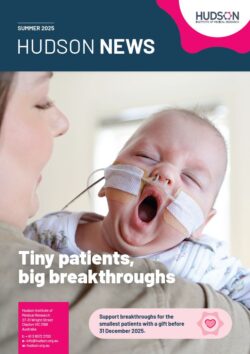Osteoporosis


Osteoporosis
Osteoporosis is known as the silent disease – people are unaware that they have it until they experience a fracture. While 924,000 Australians are diagnosed with osteoporosis, because the symptoms are not overt, significantly more people have it but do not know.
A simple sneeze, cough, hug or bumping into an object can cause a fracture in a person with osteoporosis. Osteoporosis-related fractures are mostly in the wrist, spine or hip. In 2017-18 there were 93,321 hospitalisations for minimal trauma fractures and 6,838 hospitalisations for osteoporosis in people over 50 years, but it is not only older people who have osteoporosis.
What causes osteoporosis?

Why is osteoporosis serious?

Who is affected by osteoporosis?

What are osteoporosis symptoms?

Risk factors for osteoporosis?

Preventing osteoporosis

Diagnosis and treatment

Our osteoporosis research
Our osteoporosis researchers are improving care and outcomes through improved understanding of mechanisms of bone loss and treatments.
Bone disease in patients with chronic diseases

 Molecular studies, clinical guidelines | The path to osteoporosis has many influencing factors. Chronic disease in childhood and adolescence hinders the development of bone and achieving peak bone mass, with significant effects on bone and fracture risk into adulthood. Dr Fran Milat’s group is investigating the burden of bone disease in Australians with chronic disease including cerebral palsy, spina bifida, transfusion-dependent haemoglobinopathies, renal failure, premature ovarian insufficiency (POI) and diabetes. Their aim is to identify the mechanisms that contribute to bone health, examine what investigations can help assess fracture risk and investigate treatments for bone disease in these conditions.
Molecular studies, clinical guidelines | The path to osteoporosis has many influencing factors. Chronic disease in childhood and adolescence hinders the development of bone and achieving peak bone mass, with significant effects on bone and fracture risk into adulthood. Dr Fran Milat’s group is investigating the burden of bone disease in Australians with chronic disease including cerebral palsy, spina bifida, transfusion-dependent haemoglobinopathies, renal failure, premature ovarian insufficiency (POI) and diabetes. Their aim is to identify the mechanisms that contribute to bone health, examine what investigations can help assess fracture risk and investigate treatments for bone disease in these conditions.
Clinician-researcher, Associate Professor Fran Milat is the Deputy Head of Endocrinology and Head of the Metabolic Bone Clinic at Monash Health. The clinic was established in 2010 to addresses the increasing demand for specialised care of young adults with bone disorders and patients with osteoporosis linked to neurological disease, haematological conditions, cerebral palsy, spina bifida, renal disease, liver disease and malignancy.
Lead Researcher | Associate Professor Frances Milat
Bone health in neurological disorders/stroke

Bone health in thalassaemia

Bone Health in chronic kidney disease

Osteoporosis news
Osteoporosis collaborators
Explore our labs
Support for people with osteoporosis
Hudson Institute scientists cannot provide medical advice. Ask your doctor about a bone density test. GPs can refer you to the Metabolic Bone Clinic at Monash Health by addressing the referral to Professor Peter Fuller, Head of Endocrinology through the health services eReferral system.
Keep up-to-date with our latest discoveries


 Molecular studies. Treatments. Thalassaemia major is the most severe form of thalassaemia with a high prevalence of osteoporosis and fractures. There are many reasons for bone loss including a range of endocrine risk factors, iron chelators and iron toxicity. Hypercalciuria has recently been discovered to be an important risk for bone loss. Dr Phillip Wong’s goal is to investigate whether hydrochlorothiazide, a treatment for high blood pressure, is effective in the prevention of hypercalciuria and treatment of osteoporosis.
Molecular studies. Treatments. Thalassaemia major is the most severe form of thalassaemia with a high prevalence of osteoporosis and fractures. There are many reasons for bone loss including a range of endocrine risk factors, iron chelators and iron toxicity. Hypercalciuria has recently been discovered to be an important risk for bone loss. Dr Phillip Wong’s goal is to investigate whether hydrochlorothiazide, a treatment for high blood pressure, is effective in the prevention of hypercalciuria and treatment of osteoporosis. Molecular studies. New treatments. Chronic kidney disease (CKD) can cause bone loss through changes in many minerals and hormones including calcium, phosphate, parathyroid hormone and vitamin D metabolism. Fracture rates can be increased up to 60 -fold in patients with CKD compared to the general population and these patients are much more likely to die after a fracture. Dr Jasna Aleksova investigates the mechanisms where CKD can lead to bone fragility and assesses new tools to better diagnose bone fragility in these patients. The aim of this project is to explore which mechanisms could be used to predict fracture in order to better treat osteoporosis in adults with chronic kidney disease.
Molecular studies. New treatments. Chronic kidney disease (CKD) can cause bone loss through changes in many minerals and hormones including calcium, phosphate, parathyroid hormone and vitamin D metabolism. Fracture rates can be increased up to 60 -fold in patients with CKD compared to the general population and these patients are much more likely to die after a fracture. Dr Jasna Aleksova investigates the mechanisms where CKD can lead to bone fragility and assesses new tools to better diagnose bone fragility in these patients. The aim of this project is to explore which mechanisms could be used to predict fracture in order to better treat osteoporosis in adults with chronic kidney disease.